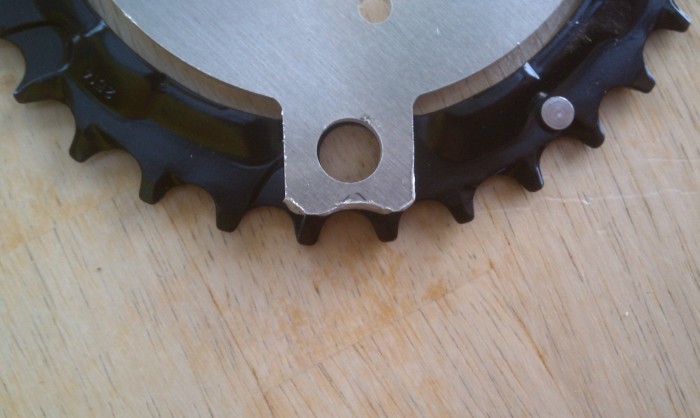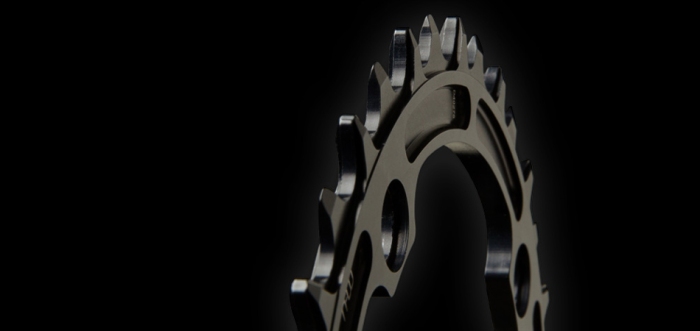Most BBS02 units ship with either the 48 or 46 tooth Chaining. The first thing you will notice about the stock chainring is the weight (over 400grams). It is stamped in steel and the heft makes it clear that it is unlikely that you’ll have to be replacing it on a regular basis. One of the issues with direct drive is that you can wear through the chains, chainrings and cassettes quite fast when you consider that the average human puts out about 100 watts of power and the BBS02 easily puts out close to 1000.

Lekkie custom ring is about 1/4 the weight of the stock chainring and also features Narrow\Wide. Review is here
If you try shifting under load you will break chains and wear your teeth down fast. If your chainline is not right your bike will skip under load. If you use cogs and chainrings that are too soft you will be changing them out several times a year. Everyone wants their bike to just work all the time and not have to deal with these issues. The best way to get around these problems is intelligent chainring selection ahead of time.
The first decision you must make is whether you want to go with a stock Bafang chainwheel. There are 4 sizes which make a big difference in performance. 44, 46, 48 and 52 teeth chainwheels are all usually in stock at em3ev . These chainwheels are heavy but offset about 1 cm toward the Bottom bracket by wrapping around the gearing assembly. If you want to trailride and keep a stock ring the only choice that makes any sense in the front ring is the 44 tooth and I’m of the opinion that even that is way too big. If you want to consistently go over 25 mph on the road and still be able to pedal along then the only logical choice is the 52 T ring. If you have a recumbent or a trike with small wheels, or a trike then the 52T will not be big enough and you will need to get a custom adapter.
There are 2 kinds of custom adapters, the BA 130 adapter sold by California E-bike here is designed to accept large 5 hole chainwheels. If you have a smaller wheelsize or are building a high speed commuter and don’t want the heft of the stock chainwheel this is your only real option.
The 2nd kind of custom adapter is the BA 104 adapter sold here by California E-bike. The cheapest adapter I have found for the BA104 is from Ballarate ebikes in Australia for $25 although their adapter is machined (older versions were plasma cut). The cheapest you’ll find in the US is this one from High Powered Cycles for $35. This adapter is useful if you want to go smaller than 44T which is primarily useful if you have a larger wheel diameter (think 29er or 26 fatbike) and/or want high torque and lower top speed. For most singletrack trailriding I have found that a 32T or 34T chainring is ideal. These adapters are nice because you can mount TWO chainrings on the front, keep your front derailer and have many more options for gearing. The disadvantage is that when you are on the larger chainwheel (toward the pedal) your chainline will be such that you will only have access to the smaller cogs. Since you will only want the big ring at higher speeds that is not much of an issue after all.

Only 2 weeks of use on a mid drive unit with an alloy chainring. You can pick your teeth with these gears they are so sharp.
One thing to keep in mind when picking custom chainrings to use is that the lightest chainrings will often be made of softer alloys. If you want to maximize your usage and minimize your replacements there is really only one choice for material, chrome plated steel. The same holds true for the cogs in the rear. Lightweight cassette will wear quickly especially if you are using higher speeds on the smaller cogs. A 11T cog running at 30 mph made of lightweight alloy is not going to last very long at all. The shimano CS-HG61 steel cassette available here for about $34 is a great value for a 9 speed and goes from 12T all the way up to 36T although it is pretty hefty at 424grams.
The most important thing to remember when picking the front chainwheel is that you want to spend 90% of your pedaling time in the CENTER of the back cassette. Don’t pick a front ring that will keep you always on the smallest cog in the back and likewise you should not be spending all your time on the largest cog either. The chains last longest when there is a clean chainline and the power is being applied in a more or less straight line.

You need to grind down the cheaper adapters if you use a 32T or smaller so the chain will settle all the way down on the teeth.
For singletrack riding I usually have a 34 or 36 in the front chainring and tend to spend most of my time riding the 30-34 tooth cogs in the back (granny gears). This maximizes the torque but tops out at about 8-9mph. Honestly when I am out of control flying through the woods with the bike sliding out from under me I don’t really have any desire to go over 10mph. With nearly a 1:1 ratio between the front and the back you will find that the bike will climb up and over almost anything you would want to hit.
To keep the chain from getting wedged between the chainring and the drive unit there are three options. The N-Gear chainguards is an inexpensive option that works reasonably well. The only problem is that it is too far of a reach from the seat-tube to the chainring so the metal guard has to be bent. The chainguard doesn’t keep the chain from coming off, but it does keep it from getting jammed down in between the chainring and the housing and bending your BCD104 adapter.
The cheapest option for unintentional chain derailment is to use the old front derailleur as a stand alone chain guide. You can pull off the shifter and the cable and just position the front derailleur so if the chain tries to jump it will get caught. It works best to have a long screw to replace the default stop-adjustment screw on your front derailleur, most bike shops should be able to dig something up for you. Often when you use this solution the chain may hit the guide in the lowest and\or highest gears.

The Race Face Narrow/Wide Ring is the best device I’ve found for preventing accidental chain detachment
The last and best option is to use a narrow\wide chainring. There are many manufacturers who make these, although to date there is no one making them out of steel that I know of. Raceface narrow\wide chainring is the only one I have tested and I can say that it works better than the other 2 options I have tried by far.
An even better solution that the Raceface is the new Lekkie Bling-Ring which is machined specifically for the BBS02 drive unit. For it’s size it is incredibly light and also moves the chainline over towards the bike a whopping 9mm. The full review of this chainring can be found here and it runs about $90 if bought from Matt at Empowered Cycles here.
Don’t forget to lube your chain after every ride. It makes the biggest difference in chain wear and tear. I recommend bringing you bike inside at night as the cold wreaks havoc on the greased bearings and the chain, esp when it drops way below zero.
Ride on.
Karl




No comments:
Post a Comment